|
Location: Tres Zapotes,
Veracruz, Mexico. |
Grid Reference:
18� 28' N, 95� 26' W. |
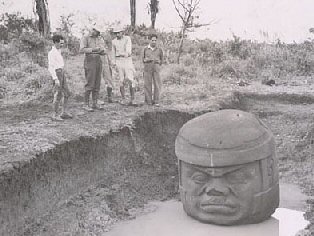
 Tres Zapotes:
(Olmec Capital).
Tres Zapotes:
(Olmec Capital).
Located on the
slopes of the Tuxtla mountains, this is one of the most important
Olmec cities, and the first to be written about in 1868, along with
the first reports of colossal heads. Tres Zapotes is sometimes
referred to as the third Olmec Capital, as it followed on the demise
of both La Venta and San Lorenzo.
Of particular
interest to archaeology is that the site was continuously inhabited
for over 2000 years (1)
(Layout
of Site)
|
Tres Zapotes (Three Sapodillas). |
Founded c. 1500 BC, it is believed that Tres Zapotes
achieved prominence during the Early Formative
period, between 1200 and 900 BC. During the Late
Formative, 400 BC to 100 AD, when other Olmec
centres such as La Venta were already in decline,
Tres Zapotes sculptures showed the influence of
other artistic styles, such as that of Izapa in the
Guatemalan Highlands, and other regional styles
(2).
This indicates ongoing trade connections with
other cultures, which would have influenced Tres Zapotes.
Despite the fact that the Olmec culture may have no
longer existed as such, Tres Zapotes continued to be
occupied until well into the Early Postclassic
(1000-1200 AD).
There have been several important discoveries at
Tres Zapotes, not least of all, the first discovery
of a monumental Stone head, which have since
inspired much debate over the origin and influence
of Olmec cultural connections.
The Stone Heads
It was
near Tres Zapotes that the first colossal head was
discovered in 1862 by Jos� Melgar. To date, only two
'monumental' heads have
been found locally, labelled "Monument A" and
Monument Q". Smaller than the colossal heads at
San Lorenzo, they measure slightly less than
1.5 m (4 ft 11 in) high. Together with the cruder
and significantly larger head at Rancho la Cobata,
these colossal heads show evidence of a specific style
of dress and sculpture, differing from that of San
Lorenzo and La Venta.
Scarcely 10 km (6 mi) to the east stands Cerro el Vig�a, an
extinct volcano and important source of basalt and other volcanic stone, sandstone, and clay.
The nearby small site of Rancho la Cobata, on the northern flank
of Cerro El Vig�a, may have functioned as a monument workshop �
most of the basalt stonework at Tres Zapotes was crafted from
the colossal, "spheroid", smooth-faced boulders found even today
at the summit of Cerro El Vig�a. Some of these boulders are more
than 3 meters in diameter.
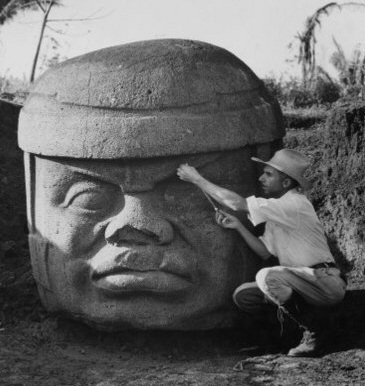

Monument A: Height 1.47m (4.82 ft). Carved from a block of
Basalt. Current location, Community museum, Veracruz. Monument Found
near the Calendar stone (Stela C), Stirling (seen kneeling beside
it) had this to say of it:
"...The head was
a head only, carved from a single massive block of basalt, and
it rested on a prepared foundation of un-worked slabs of stone
... Cleared of the surrounding earth it presented an
awe-inspiring spectacle. Despite its great size the workmanship
is delicate and sure, the proportions perfect. Unique in
character among aboriginal American sculptures, it is remarkable
for its realistic treatment. The features are bold and amazingly
Negroid in character..." (3)
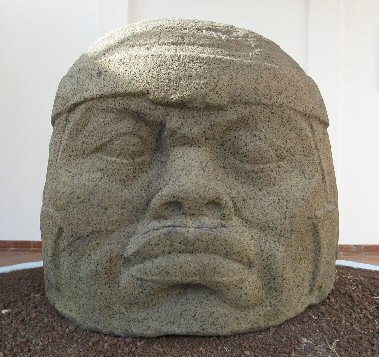
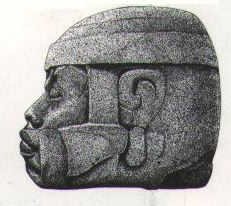

Monument Q -
Height 1.47m (4.82 ft). Carved from a distinctive porphyritic basalt and
weighing over eight tons, this was the second colossal
head to be discovered at Tres Zapotes. Current location
Santiago Tuxtla Museum, Veracruz.
Image (Right): The rear of Monument Q showing
Ethiopian style braided hair. This monument in particular offers one of the strongest arguments
in favour of the heads representing people of African origin.
It is interesting that the two colossal heads
found at Tres Zapotes, monument A and monument
Q, were not found in the core zone of the site,
but rather in the residential periphery, in
Group 1 and Nestepe Group.
(Old World - New World contact in
Pre-Columbian America)
(Images
of All the Mexican Stone-Heads)
The
Olmec Long-Count:
In Addition to the
stone heads, Tres Zapotes excavations revealed
the earliest example of a dated 'Long Count'
inscription from 'Stela C', in the year of 31 BC.
Tres Zapotes Stela C: Tres Zapotes is
famous for Stela C, a rectangular stone block
with a post-Olmec Izapa-style mask on one side,
and a Long Count date expressed in bars and dots
on the other (below). The date, 7.16.6.16.18
6 Eznab (31 B.C.), was at the time, the Mesoamerica's
oldest 'Mayan' Long Count inscriptions. What was shocking
about this was that Tres Zapotes was not a Maya
site�not in any way at all. It was entirely,
exclusively, unambiguously Olmec. This
suggested that the Olmecs, not the Maya, must
have been the inventors of the calendar, and
that the Olmecs, not the Maya, ought to be
recognized as �the mother culture� of Central
America.

Illustration of
Stela C: Front and Back, showing the date 31 BC.
This very important
fact has revealed several interesting aspects of
Olmec culture. The Olmecs
were much, much older than the Maya. They�d been
a smart, civilized, technologically advanced
people and indeed, it appears that it was they,
and not the Maya, who
invented the bar-and-dot system of calendrical
notation, including the enigmatic starting date of 13
August 3114 BC.
In addition,
and of equal importance, a nearby stela has
produced the longest glyph text in Meso-America,
leading to a question over the origin of writing.
|
Tres Zapotes: Gallery of
Images.

Tres Zapotes Stela D:
This monument
shows the open mouth of an animal, possibly
representing the Earth Monster. Three human
figures are carved in low relief in the back of
the mouth. In 1939 Stirling described the style
of this stela as �quite suggestive of Mayan
art.� This was, however, before the style was
recognized as preceding the Maya and before the
name Olmec was applied to the style and to the
civilization that produced it.
This
single Stela took 20 men to remove it from the
ground. It has been compared to the Izapa Stela, and
is tentatively dated to c. 600 - 100 BC
(4).

'One of the major
differences between the ancient civilizations of Eurasia and those
of the Americas was the absence of wheeled transportation in the
latter...'
Soon afterwards the American
archaeologist made a second unsettling discovery at Tres Zapotes was
also the place where archaeologists unearthed the first example of a
Pre-Columbian wheeled object. Since then several more have been
found in both Olmec and Mayan locations dispelling the myth that the
wheel was unknown before the conquest.
(Other
Examples of the Wheel in Pre-Columbian America)
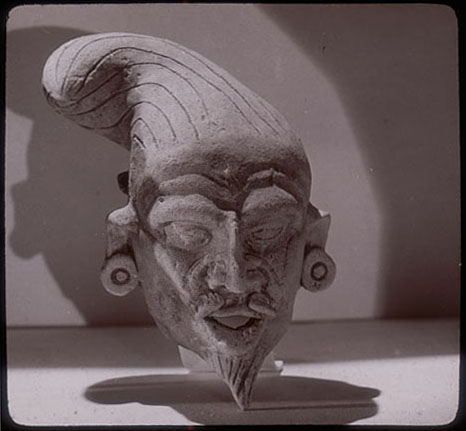
Bearded Olmecs.?
This particularly
significant discovery is of the head of a man, with pointed beard,
earplugs and headdress, from one of the mounds near Tres Zapotes.
Neither the beard
of the moustache are found in the Amerindian genotype.
There are several
other bearded figures in Olmec art, again placing an emphasis on the
idea that the Olmecs were a multi-cultural society with influences
from different cultures from the both Pacific and Atlantic..
(Photo Credits:
Smithsonian Olmec Legacy)
(Olmecs
Homepage)
(La
Venta) (San
Lorenzo)
(The
Olmec Stone Heads)
(Mexico
Homepage)
(Pre-Columbian
Americas) |









